An in-depth guide to the amps and effects pedals in Stevie Ray Vaughan’s arsenal
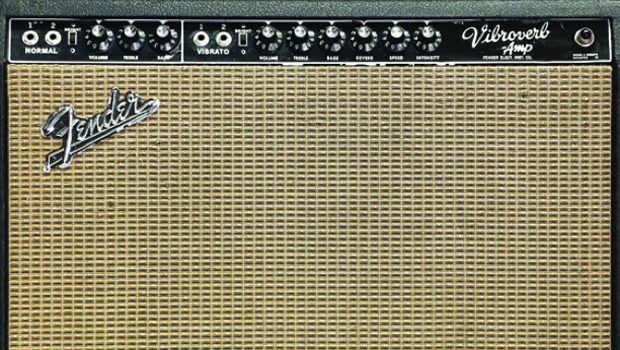
Stevie Ray Vaughan’s guitar tone was as dry as a San Antonio summer and as sparkling clean as a Dallas debutante, the product of the natural sound of amps with ample clean headroom.
However, Vaughan occasionally used pedals to augment his sound, mainly to boost the signal, although he occasionally employed a rotating speaker cabinet and wah pedals for added textural flair.
Vaughan’s fierce playing style was the key to his distinctive sound, but it was also very hard on his equipment, and over the years his amps and pedals were heavily modified to withstand the abuse.
AMPS
1980 Marshall model 4140 Club and Country
Most guitarists with multi-amp rigs will use Fender amps for clean tones and Marshalls for distortion and overdrive, but Vaughan did the opposite. However, it made sense that he used a Marshall for clean tones, as his Marshall was a model 4140 Club and Country combo with two 12-inch speakers, which was Marshall’s version of a Fender Twin Reverb. With 100 watts of output and a power amp section driven by KT77 tubes, the Club and Country provides more clean headroom than the typical Marshall design. The amp remained in Vaughan’s rig until early 1984, when a Dumble Steel String Singer replaced it.
1964 Fender Vibroverb
All the latest guitar news, interviews, lessons, reviews, deals and more, direct to your inbox!
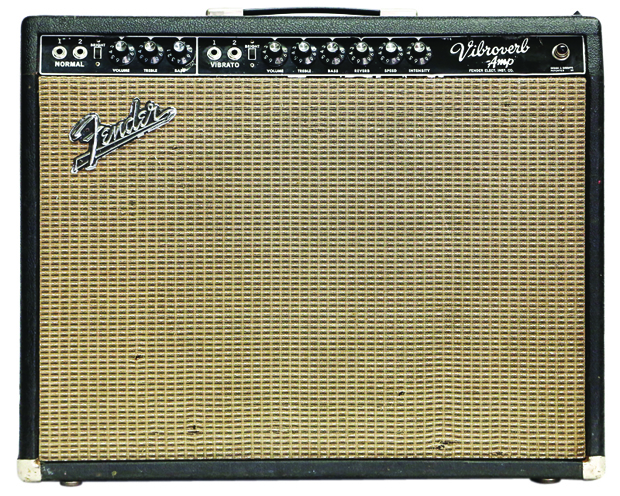
The heart and soul of Vaughan’s live rig for most of the Eighties was a pair of Fender Vibroverb combos. The Vibroverbs, each featuring a single 15-inch speaker, were the source of Vaughan’s cranked-up overdrive tones, and he also used one of the combos to power his Fender Vibratone rotating-speaker cabinet throughout his career. Introduced in 1963, the Vibroverb was Fender’s first amp with built-in reverb.
Fender initially produced the Vibroverb with two 10-inch speakers and brown Tolex covering, but in late 1963 the model’s design switched to a single 15-inch speaker and black Tolex. Vaughan always assumed that his Vibroverbs were one serial number apart from one another based on the numbers “5” and “6” on the tube charts, but those are production run numbers and the actual serial numbers were 36 numbers apart.
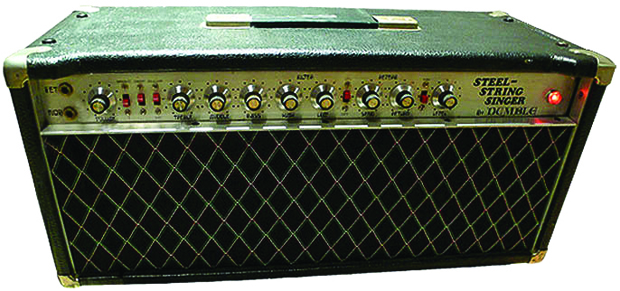
Dumble Steel String Singer
Vaughan first discovered the amps of legendary Los Angeles boutique-amp pioneer Alexander “Howard” Dumble when recording Texas Flood at Jackson Browne’s Downtown Studios in 1982, using Browne’s Dumbleland 300-watt bass amp to record most of the tracks during the sessions.
Impressed with the Dumble amp’s ability to maintain crystal-clean tone even when subjected to his aggressive low E string attack, Vaughan custom-ordered a Steel String Singer head, which Dumble beefed up with 6550 tubes and 150 watts of output instead of the model’s usual 6L6 tubes and 100 watts. Vaughan usually used his Dumble head with a custom-built 4x12 cabinet loaded with Electro-Voice speakers.
When delivered in 1984, the Steel String Singer immediately became the main clean amp in Vaughan’s rig, earning the “King Tone Consoul” nickname that Vaughan bestowed upon it. Vaughan acquired a second Dumble Steel String Singer in 1986.
Mid-Sixties Fender Super Reverb
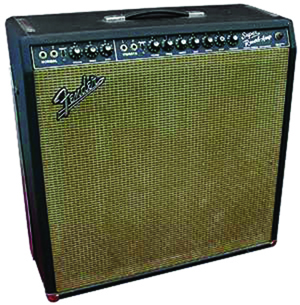
Before Vaughan bought his Marshall Club and Country amp, a mid-Sixties blackface Fender Super Reverb was the source of his clean tone. When Vaughan started playing increasingly larger venues in 1983, he added a pair of Super Reverbs to his rig, which he used along with his Vibroverbs.
Like the Vibroverb, the Super Reverb is powered by two 6L6 tubes and provides 40 watts of output, but because it has four 10-inch speakers (Vaughan loaded Electro-Voice speakers in his Super Reverb amps) instead of a single 15-inch speaker it provided the louder clean headroom Vaughan needed onstage.
Eventually, the Super Reverbs replaced the Vibroverbs as the source of his onstage overdrive tones, although Vaughan kept one Vibroverb in his rig exclusively for driving the Vibratone rotating speaker cabinet. During his 1990 tour, Vaughan replaced the Super Reverbs with a pair of Fender’s newly released ’59 Bassman Reissue amps.
Fender Twin Reverb
For his 1985 Japan tour, Vaughan used a pair of Fender Twin Reverb amps (a mid-Sixties 85-watt blackface model and a late-Seventies 100-watt silverface version with master volume) in place of his Dumble Steel String Singer head. The Twins disappeared from his rig after that tour, only to resurface for a brief period in 1987 when they temporarily replaced his Vibroverb combos.
Early Seventies Marshall model 1967 Major Lead
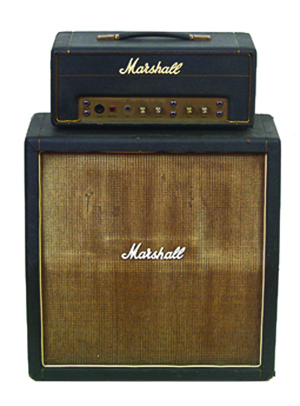
As Vaughan’s insatiable appetite for power increased, so did the size of his onstage rig, until 1988, when he decided to simplify his multi-amp setup by stripping it down to a pair of high-powered amps: his 150-watt Dumbles and a 200-watt Marshall Major Lead head. Vaughan experimented with a variety of speaker cabinets for the Marshall, including huge 4x15 and 8x10 cabinets designed for bass, before settling on a 4x12 loaded with Electro-Voice speakers like he used with his Dumbles.
If the Marshall Major lasted through the set (this model’s linear design frequently caused intense voltage spikes that arced across adjacent tube sockets and blew tubes), Vaughan would use it to perform a raucous version of “Voodoo Child (Slight Return)” to close his set.
In Step session amps
When recording In Step, his last studio album with Double Trouble, Vaughan had 32 different amps at his disposal, including a 1962 Fender Twin, a mint original 1959 Fender Bassman, and vintage Fender Harvard and Magnatone amps, in addition to the Fender Vibroverbs, Dumble Steel String Singers, and various Fenders and Marshalls he used onstage. When recording each song, Vaughan experimented with different combinations of amps and settings until he dialed in the sound he wanted.
EFFECTS
Ibanez Tube Screamer
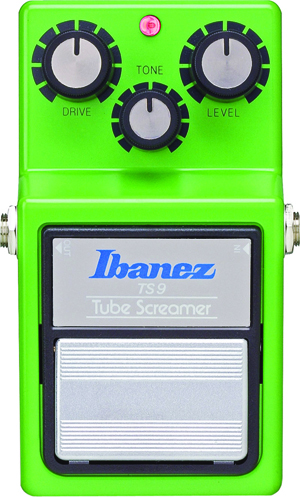
According to pedal-geek lore, Vaughan was a big fan of the TS808 version of the Ibanez Tube Screamer, but evidence in the form of stage photos, live videos, insurance documents and customs declarations reveal that the TS9 version of the Tube Screamer was his preferred choice from 1982 through most of the Eighties.
Vaughan usually used his TS9 to provide a clean boost to his Fender Vibroverbs for solos, with the level control all the way up and the drive control set to relatively low gain.
In 1988, a new Ibanez TS10 Tube Screamer replaced the TS9 in his pedal board, which Vaughan generally used to generate high-gain distortion (with both the drive and level controls boosted) that wasn’t otherwise available from his Dumble and Marshall Major rig.
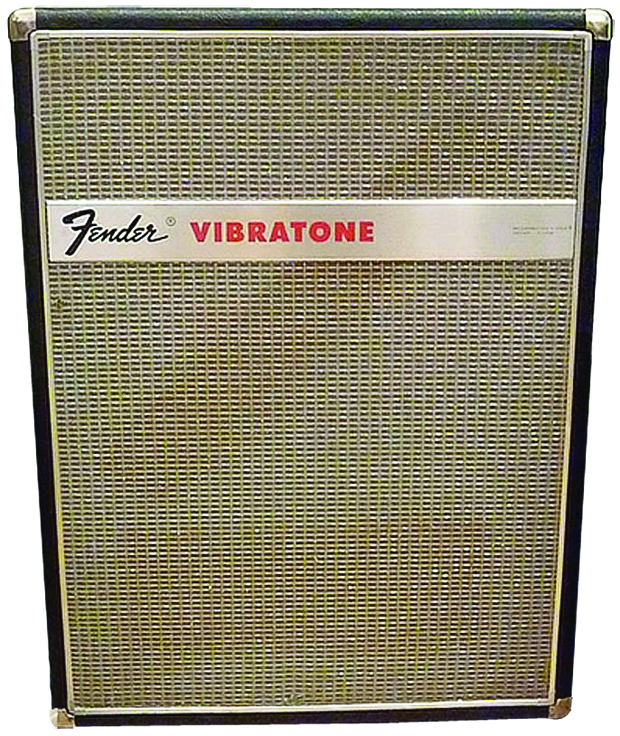
Fender Vibratone
The lush rotating-speaker effects heard on Vaughan tracks like “Cold Shot” and “Couldn’t Stand the Weather” were generated by a Fender Vibratone speaker cabinet. Similar to a Leslie Model 16, the Fender Vibratone is designed for gigging guitarists and features a rugged, roadworthy cabinet covered in black Tolex.
More importantly, the Vibratone is also designed for use with a standard guitar amp and features a guitar speaker that emphasizes crucial midrange tones instead of the full-range, two-way woofer and tweeter speaker array found in most Leslie cabinets. Fender sold the Vibratone from 1967 through 1972, and it is still considered one of the best true rotating speaker effects for guitarists.
Roland SDD-320 Dimension D
Although Vaughan didn’t use the Roland Dimension D in his live rig, it was a secret weapon in the studio, where he often added it to his guitar tracks during mixing. Vaughan first discovered the Dimension D while mixing his guitar tracks on David Bowie’s Let’s Dance, and he liked how its subtle chorus effect thickened his guitar sound without changing his natural tone significantly like other chorus effects frequently do.
The Dimension D was used on the solos to “Mary Had a Little Lamb” and “Pride and Joy” on Texas Flood and most of the solos on Couldn’t Stand the Weather. During mixing, Vaughan would add the Dimension D effects himself via the effects send/return controls on the mixing console.
Vox V846 wah
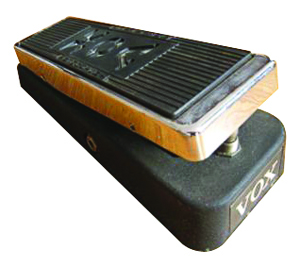
Vaughan’s wah pedal of choice was a Vox V846 from the Sixties that originally belonged to Jimi Hendrix. Jimmie Vaughan, Stevie’s brother, acquired the pedal from Hendrix when Jimmie’s band shared a bill with the Experience in Fort Worth. Vaughan owned several other Vox wah pedals and was allegedly very fond of an early Seventies version with a Japanese TDK inductor.
Vaughan used the Vox wah on his Hendrix covers and “Telephone Song” on the Vaughan Brothers’ Family Style, and he famously used two wahs at once to record “Say What.”
Dallas-Arbiter Fuzz Face
Vaughan tended to prefer clean tones and natural tube-amp overdrive, but in 1988 he added an original Sixties Dallas-Arbiter Fuzz Face pedal to his rig when he became obsessed with emulating Jimi Hendrix’s signature sounds.
Unfortunately, the Fuzz Face’s germanium transistors were extremely unreliable when exposed to hot stage lights or the sun during outdoor gigs. Vaughan collected several Fuzz Face pedals, and he would try several during sound check to choose the one he thought sounded best that particular day. Eventually, he got tired of the unreliable transistors in his Fuzz Face pedals, so he had them modified by his amp tech César Diaz, who later used the modifications as the basis for the Diaz Texas Square Face pedal.
Tycobrahe Octavia
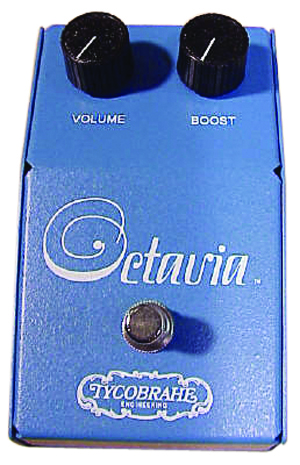
Another key effect that Vaughan used to emulate Hendrix tones was an Octavia fuzz pedal that produces octave-up effects. Vaughan initially used Roger Mayer Octavia pedals (housed in distinctive “spaceship” metal boxes), but when Diaz located three New Old Stock Tycobrahe Octavia pedals, Vaughan switched to those.
His guitar tech, Rene Martinez, says that Stevie thought the Tycobrahe pedal produced the best Octavia effect he had ever heard. Vaughan especially liked how the Octavia sounded when used along with a Tube Screamer.
Chris is the co-author of Eruption - Conversations with Eddie Van Halen. He is a 40-year music industry veteran who started at Boardwalk Entertainment (Joan Jett, Night Ranger) and Roland US before becoming a guitar journalist in 1991. He has interviewed more than 600 artists, written more than 1,400 product reviews and contributed to Jeff Beck’s Beck 01: Hot Rods and Rock & Roll and Eric Clapton’s Six String Stories.

